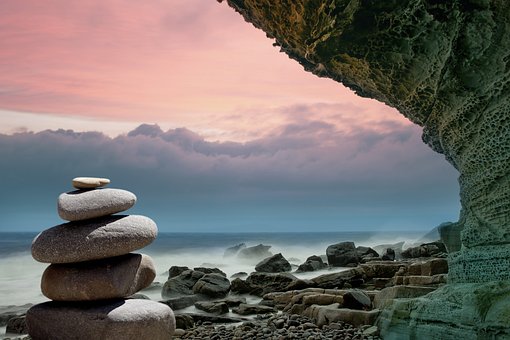In art, as in love, stories of fidelity are tied. Director of the Grenoble Museum, Guy Tosatto wanted, on the eve of his retirement, to pay tribute to four artists whom he has accompanied for a long time and who have presented here in monographic exhibitions: the French painter Philippe Cognée and three sculptors, the Spanish Cristina Iglesias, German Wolfgang Laib and Italian Giuseppe Penone.
He brought together this European quartet around “De la nature”, a title borrowed from Lucretia. While the state of the planet is causing growing concern, Guy Tosatto confides, in this very personal exhibition, “having wanted to show works that speak of the deep bond of men with their environment, works whose depth and beauty pull us upwards, towards a form of hope despite everything”.
At the start of the journey, Philippe Cognée’s canvases do not elude a certain anxiety, with their blurred, trembling shapes, painted with encaustic, then heated and crushed with an iron. After having painted a lot of urban views, the artist has returned, for a few years, to natural landscapes, like these paintings of brushwood, snow-covered or charred forests echoing the terrible fires of the summer of 2022. side, its faded flowers, captured close-up on black backgrounds, exude a poisonous perfume of eroticism, and its Sand castle evoke ruined monuments, collapsing civilizations…
A matrix cave
In the next room, a gray temple stands, enigmatic. Half burial chamber, half sacred temple. It is pierced with an opening through which Cristina Iglesias invites visitors to enter this sculpture in concrete, resin and marble powder. And even to touch it. Because what is offered inside is a sensual cave, a labyrinth with wrinkled and wet walls, flowered with small limestone concretions.
A tomb of flesh where one ventures, lulled by the singing sound of drops of water. On the opposite wall, the Spanish artist presents 12 Cave studiesaccording to hondalea, the gilded bronze sinkhole she created in 2021 in a disused lighthouse in the bay of San Sebastián, her hometown. In this sculpture, the waters rise and surge at regular intervals, before receding, recalling the underworld of the abyss and the origins of terrestrial life.
After the works imprinted with finitude by Philippe Cognée and the large matrix tomb of Cristina Iglesias, the works of Wolfgang Laib, an artist steeped in oriental spirituality, seem to offer themselves in a form of radiant revelation. Placed in the center of the room, one of his Brahmanda, huge egg sculpted in black granite and anointed with sunflower oil, represents a primordial cosmic nucleus.
It thrones between two luminous, almost dazzling works, as if sprung from this block of night. One is a carpet of incandescent pollen, carefully collected and then sprinkled by Wolfgang Laib, in a ritual celebrating the fragile fertility of the world. The other, titled Crossing the River – For Bhodhidarma, offers a series of diaphanous, barely perceptible landscapes, drawn in white pastel on white paper, in a meditative exercise of self-effacement, in homage to this founder of Zen.
Ghosts come back to life
Death is only a passage, life is always reborn, in other forms, the works of Giuseppe Penone whisper to us then, in a final consolation. This one is orchestrated around six Gesti vegetalispectral human forms, in bronze, similar to moults of carnal envelope, springing from large pots of humus and invaded by vigorous vegetation.
On the walls all around, Guy Tosatto has hung large verdant shrouds, Verde del Bosco, loose canvases on which the artist has collected the imprints of trees by rubbing the bark with foliage. In one of these imaginary woods, dated 1984, Penone stuck, floating among the trunks, the nightgown of his mother, who had just died at the time. A ghost image that he immediately covered with the imprints of young twigs.
————
To prolong exposure
The catalog of this exhibition is accompanied by four artist’s books brought together in a box. Philippe Cognée and Wolfgang Laib unveil series of drawings, Giuseppe Penone engravings, and Cristina Iglesias photographs of another monumental labyrinth, exhibited during the summer of 2022 in London. Ed. Lienart-Grenoble Museum, 376 pages, €40.
A monograph on Philippe Cognée just published, including an interview with the artist and texts by Marc Donnadieu and Guy Tosatto. Ed. Skira/Galerie Templon, 287 pages, €45. A rich dive into the art of this singular painter, in the spotlight in 2023 with three exhibitions at the Musée de l’Orangerie and the Musée Bourdelle in Paris as well as at the Musée de Tessé in Le Mans.

